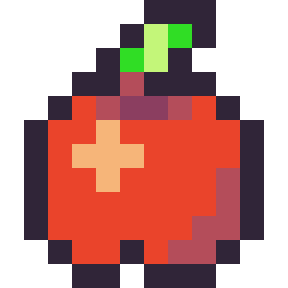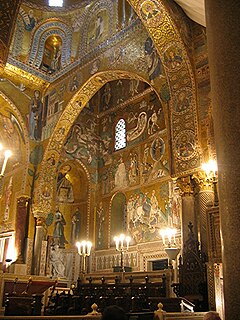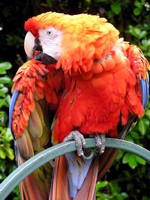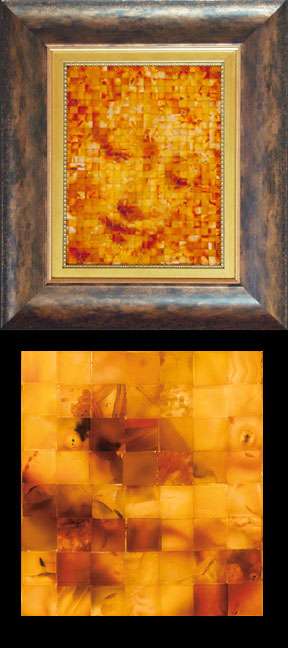
The Graphics Interchange Format is a bitmap image format that was developed by a team at the online services provider CompuServe led by American computer scientist Steve Wilhite and released on 15 June 1987. It has since come into widespread usage on the World Wide Web due to its wide support and portability between applications and operating systems.

In digital imaging, a pixel, pel, or picture element is a smallest addressable element in a raster image, or the smallest addressable element in an all points addressable display device; so it is the smallest controllable element of a picture represented on the screen.

In computer graphics and digital photography, a raster graphic is a dot matrix data structure that represents a generally rectangular grid of pixels, viewable via a computer display, paper, or other display medium. Raster images are stored in image files with varying dissemination, production, generation, and acquisition formats.

Tiles are thin objects, usually square or rectangular in shape. A tile is a manufactured piece of hard-wearing material such as ceramic, stone, metal, baked clay, or even glass, generally used for covering roofs, floors, walls, or other objects such as tabletops. Alternatively, tile can sometimes refer to similar units made from lightweight materials such as perlite, wood, and mineral wool, typically used for wall and ceiling applications. In another sense, a tile is a construction tile or similar object, such as rectangular counters used in playing games. The word is derived from the French word tuile, which is, in turn, from the Latin word tegula, meaning a roof tile composed of fired clay.

Pixel art is a form of digital art, created through the use of software, where images are edited on the pixel level. The aesthetic for this kind of graphics comes from 8-bit and 16-bit computers and video game consoles, in addition to other limited systems such as graphing calculators. In most pixel art, the color palette used is extremely limited in size, with some pixel art using only two colors.

A Bayer filter mosaic is a color filter array (CFA) for arranging RGB color filters on a square grid of photosensors. Its particular arrangement of color filters is used in most single-chip digital image sensors used in digital cameras, camcorders, and scanners to create a color image. The filter pattern is half green, one quarter red and one quarter blue, hence is also called BGGR,RGBG, GRBG, or RGGB.

Subpixel rendering is a way to increase the apparent resolution of a computer's liquid crystal display (LCD) or organic light-emitting diode (OLED) display by rendering pixels to take into account the screen type's physical properties. It takes advantage of the fact that each pixel on a color LCD is actually composed of individual red, green, and blue or other color subpixels to anti-alias text with greater detail or to increase the resolution of all image types on layouts which are specifically designed to be compatible with subpixel rendering.

Compositing is the process or technique of combining visual elements from separate sources into single images, often to create the illusion that all those elements are parts of the same scene. Live-action shooting for compositing is variously called "chroma key", "blue screen", "green screen" and other names. Today, most, though not all, compositing is achieved through digital image manipulation. Pre-digital compositing techniques, however, go back as far as the trick films of Georges Méliès in the late 19th century, and some are still in use.

Pietra dura or pietre dure, called parchin kari or parchinkari in the Indian Subcontinent, is a term for the inlay technique of using cut and fitted, highly polished colored stones to create images. It is considered a decorative art. The stonework, after the work is assembled loosely, is glued stone-by-stone to a substrate after having previously been "sliced and cut in different shape sections; and then assembled together so precisely that the contact between each section was practically invisible". Stability was achieved by grooving the undersides of the stones so that they interlocked, rather like a jigsaw puzzle, with everything held tautly in place by an encircling 'frame'. Many different colored stones, particularly marbles, were used, along with semiprecious, and even precious stones. It first appeared in Rome in the 16th century, reaching its full maturity in Florence. Pietra dura items are generally crafted on green, white or black marble base stones. Typically, the resulting panel is completely flat, but some examples where the image is in low relief were made, taking the work more into the area of hardstone carving.

A tessera is an individual tile, usually formed in the shape of a cube, used in creating a mosaic. It is also known as an abaciscus or abaculus.
A demosaicing algorithm is a digital image process used to reconstruct a full color image from the incomplete color samples output from an image sensor overlaid with a color filter array (CFA). It is also known as CFA interpolation or color reconstruction.

In computer graphics, a palette, also called color lookup table (CLUT), is a correspondence table in which selected colors from a certain color space's color reproduction range are assigned an index, by which they can be referenced. By referencing the colors via an index, which takes less information than the one needed to describe the actual colors in said color space, this technique aims to reduce data usage, be it as processing payload, transfer bandwidth, RAM usage or persistent storage. Images in which colors are indicated by references to a CLUT are called indexed color images.
In computing, indexed color is a technique to manage digital images' colors in a limited fashion, in order to save computer memory and file storage, while speeding up display refresh and file transfers. It is a form of vector quantization compression.
The following are common definitions related to the machine vision field.
Multisample anti-aliasing (MSAA) is a type of spatial anti-aliasing, a technique used in computer graphics to remove jaggies.

In the field of photographic imaging, a photographic mosaic, also known under the term Photomosaic, is a picture that has been divided into tiled sections, each of which is replaced with another photograph that matches the target photo. When viewed at low magnifications, the individual pixels appear as the primary image, while close examination reveals that the image is in fact made up of many hundreds or thousands of smaller images. Most of the time they are a computer-created type of montage.

A pixel artist is a graphic designer who specializes in computer art and can refer to a number of artistic and professional disciplines which focus on visual communication and presentation. Similar to chromoluminarism used in the pointillism style of painting, in which small distinct points of primary colors create the impression of a wide selection of secondary and intermediate colors, a pixel artist works with pixels, the smallest piece of information in an image. The technique relies on the perceptive ability of the eye and mind of the viewer to mix the color spots into a fuller range of tones. Pixel art is often utilitarian and anonymous. Pixel design can refer to both the process (designing) by which the communication is created and the products (designs) which are generated.

Roy Feinson is a South African born software engineer, author, and artist who patented the first fully functional predictive text system that included disambiguation and local dictionary storage.

Image editing encompasses the processes of altering images, whether they are digital photographs, traditional photo-chemical photographs, or illustrations. Traditional analog image editing is known as photo retouching, using tools such as an airbrush to modify photographs or editing illustrations with any traditional art medium. Graphic software programs, which can be broadly grouped into vector graphics editors, raster graphics editors, and 3D modelers, are the primary tools with which a user may manipulate, enhance, and transform images. Many image editing programs are also used to render or create computer art from scratch.












